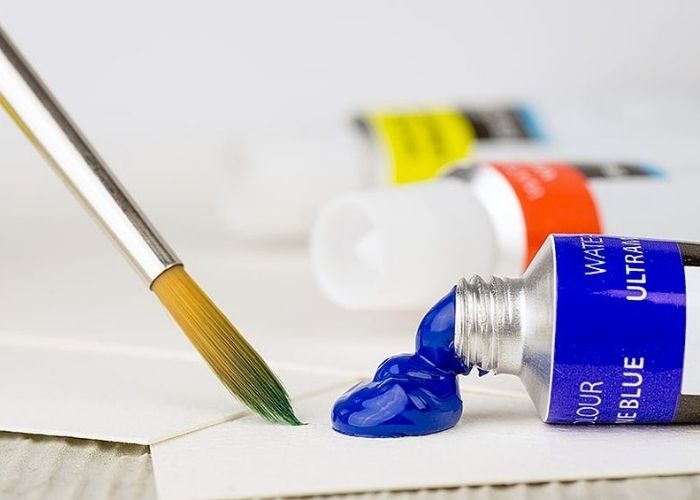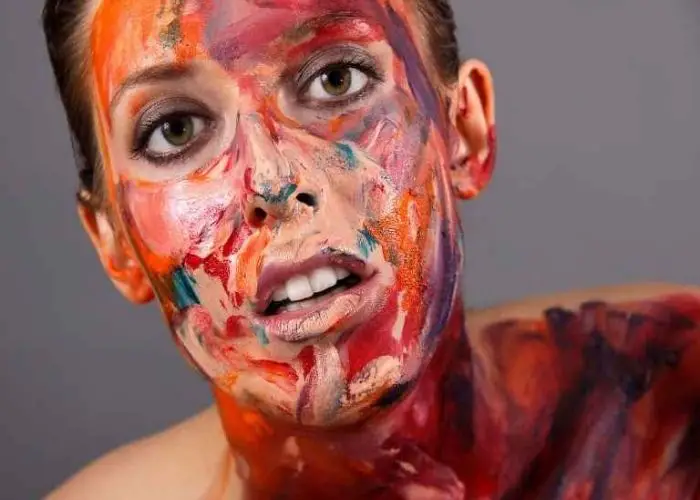Acrylic paint is a popular choice for many crafters and artists because of its versatility when compared to other craft paints. It can be used on various surfaces, including canvas, wood, metal, and glass.
And it comes in a wide range of colors, so you can find the perfect shade for your project. But what about safety? Is acrylic paint child friendly? Is acrylic paint safe for kids to use?
The answer is yes, acrylic paint is safe for kids. But there are a few things you should know about acrylic painting before you let your little ones loose with a paintbrush.
Acrylic paints are made with pigments suspended in a synthetic polymer emulsion. The pigments give the paint its color, while the polymer emulsion helps bind the pigment particles together and keep them from spreading.
Acrylic paint is non-toxic and doesn’t contain harmful chemicals. However, it can irritate the skin and eyes, so it’s important to use caution when handling it.
Is Acrylic Paint Safe for Kids
Yes, acrylic paint is safe for kids to use. Unlike oil paints, which can contain harmful chemicals, acrylics are made from water-based pigments and provide a non-toxic option for kids’ art projects.
In addition, acrylics dry quickly and clean up easily with soap and water, making them a hassle-free choice for parents.
However, it’s important to note that some acrylic paints may contain Latex, which can cause allergic reactions in some people.
If you’re concerned about your child’s safety, check the labels on the acrylic paints before purchasing them.
Is Acrylic Paint Toxic?

This is a question that we get asked a lot, and it’s understandable why. After all, we use acrylic paint on everything from our bodies to our homes, so it’s natural to want to know if it’s safe.
The short answer is yes, acrylic paint is safe for most people. However, there are some precautions you should take if you’re pregnant or have a history of allergies.
Acrylic paint is made from pigments suspended in a polymer emulsion. The pigments give the paint its color, while the polymer provides the paint with its body and durability.
When you apply acrylic paint to your skin, the pigments will eventually be absorbed into your bloodstream.
However, the amount of pigment that enters your bloodstream is very small, and it’s not enough to cause any health problems.
Also, remember to check for the expiry date of the paint before giving it out to kids. Learn more here about using expired acrylic paint.
However, if you’re pregnant, you should avoid using acrylic paint on your skin. This is because the paint can contain lead, which can be harmful to developing babies.
If you have a history of allergies, you should also be cautious when using acrylic paint.
For example, some people are allergic to the Latex used in the paint, and they may experience a reaction if they come into contact with it.
If you’re concerned about your safety, be sure to check the labels on the acrylic paints before purchasing them.
How to Use Acrylic Paint Safely
Now that we’ve answered the question, “Is Acrylic Paint Toxic?” let’s talk about how to use it safely. Here are a few tips to keep in mind:
- Always read the labels on the paint before purchasing it. This will help you avoid any potential allergens or toxins.
- If you’re pregnant, avoid using acrylic paint on your skin.
- If you have a history of allergies, check the labels for any potential allergens.
- When using acrylic paint, wear gloves and a mask to avoid inhaling fumes.
- Always wash your hands after using acrylic paints, and avoid touching your face or eyes.
- If you get paint on your skin, wash it off immediately with soap and water.
- If you get paint in your eyes, flush them out with water and seek medical attention if necessary.
Is Acrylic Paint Toxic if Swallowed?
No, it is not toxic if swallowed. However, it can cause stomach upset if a large amount is ingested.
Acrylic paint is made of pigments suspended in a polymer emulsion. Once the acrylic paint dries, the polymer chains cross-link, and the paint becomes insoluble.
This means that it is not absorbed by the body and passes through the digestive system without causing any harm.
However, ingesting large amounts of foreign substances can cause gastric upset, so it’s best to avoid letting your child eat paint.
What to do if acrylic paint Is swallowed?
While acrylic paint is safe to use, it can be dangerous if swallowed. If you or someone you know has swallowed acrylic paint, the first step is to call poison control or a local emergency room.
Symptoms of swallowing acrylic paint include abdominal pain, diarrhea, and vomiting. If the person is able to vomit, have them do so into a paper bag or bowl.
This will help prevent aspiration, which can occur when liquids are breathed in instead of swallowed.
Once the person is at the hospital, doctors will assess the situation and may give them activated charcoal to help absorb the toxins.
In most cases, swallowing acrylic paint is not harmful and will not cause any long-term damage. However, it is always best to seek medical attention to be safe.
Is Acrylic Paint Toxic to Breathe?
No, acrylic paint is not toxic to breathe. However, it can be harmful if you inhale large amounts of fumes.
When you use acrylic paint, wear a mask to avoid inhaling the fumes.
If you do accidentally inhale the fumes, open a window and get some fresh air right away. In most cases, inhaling the fumes from acrylic paint is not harmful and will not cause any long-term damage.
In case you experience shortness of breath or other respiratory problems, seek medical attention.
Is Acrylic Paint Toxic on the Skin?

No, acrylic paint is not toxic on the skin and can be used in making different acrylic skin tones. However, some people may be allergic to the Latex used in the paint.
If you have a history of allergies, be sure to check the labels on the acrylic paints before purchasing them.
When using acrylic paint, wear gloves and avoid touching your face or eyes. If you get paint on your skin, wash it off immediately with soap and water.
In most cases, acrylic paint is safe and will not cause any long-term damage. Although, if you experience any irritation or other problems, discontinue use and seek medical attention if necessary.
Non-toxic Acrylic Paint
Non-toxic acrylic paint is a type of paint that does not contain any harmful chemicals. This makes it safe to use around children and pets, and it is also less likely to cause skin irritation.
Non-toxic acrylic paint is a great alternative to traditional paint for various reasons.
- It is safe for both children and adults to use, as it does not contain harmful chemicals.
- It is just as easy to use as regular paint, so you won’t worry about any extra steps or techniques.
- It dries quickly and is very durable, so you can enjoy your paintings for years to come.
- Non-toxic acrylic paint is available in a wide range of colors, you can create any type of acrylic painting.
So if you’re looking for a safe, easy-to-use, and versatile type of paint, then non-toxic acrylic paint is a perfect choice.
Can You Finger Paint with Acrylic Paint?
Yes! You can finger paint with acrylic paint, and it can be fun. However, there are a few things to keep in mind if you want to give it a try.
First, acrylic paint dries quickly, so you’ll need to work fast. Second, the paint can be tricky to wash off, so make sure you’re working in an area where messes are no problem.
And finally, be prepared for your fingers to get a bit stained- that’s just part of the fun! If you’re up for a challenge, finger painting with acrylics can be a fun and unique way to create art.
Can You Use Acrylic Paint for Handprints and Footprints?

Many parents enjoy creating handprints and footprints of their children. This is a fun way to capture a moment in time and create a lasting keepsake. But can you use acrylic paint for handprints and footprints?
Yes – you can use acrylic paint for handprints and footprints! Acrylic paint is non-toxic and dries quickly, making it a great choice for projects involving children.
Plus, it’s easy to clean up if there are any accidents. Apply the paint to your child’s hand or foot and press it onto paper.
You can also use acrylic paint to create handprint and footprint art on fabric. Once the paint is dry, it will be permanent and can be machine washed.
Can You Use Acrylic Paint for Baby Prints?
Yes, you can use acrylic paint for baby prints. However, there are a few things to keep in mind when doing the acrylic painting.
First, be sure to choose a non-toxic brand of paint. Second, thin the paint with water to reduce the risk of skin irritation. Finally, test the paint on a small skin area before using it on your baby’s hands or feet.
Baby Safe Paint for Crafts
With so many products on the market, it can be hard to know which ones are safe for babies and toddlers. However, there is an easy way to tell if a product is baby-safe when it comes to craft paints.
Look for craft paints that are labeled “non-toxic.” These products have been specifically formulated to be safe for young children, and they will not pose any health risks if ingested.
Non-toxic paints are also safe for use on the skin, making them ideal for crafts and other activities. One popular choice is to use food-grade dyes.
These can be found at most craft stores, and they’re non-toxic and safe for babies to handle. Another option is to use specialized baby-safe acrylic paints.
These are usually made from natural ingredients, and they’re designed to be gentle on sensitive skin. You can also find baby-safe water-based paints, though these may not be as durable as other craft paints.
What is the Best Way to Use Acrylic Paint for Hand and Foot Prints?
Acrylic paint is a great medium for creating hand and footprints, as it dries quickly and can be easily cleaned up with soap and water when compared to oil paints.
However, there are a few things to keep in mind when using acrylic paint for this purpose. First, it is important to use a non-toxic brand of paint, as some cheaper brands may contain harmful chemicals.
Second, the paint should be applied to a smooth surface, such as paper or canvas. This will help prevent the paint from cracking or peeling off once it dries.
Finally, the paint should be applied in thin layers, allowing each layer to dry completely before adding the next.
What Is the Best Paint to Use for Younger Kids and Print Crafts?
There are many different types of craft paints out there, and it can be hard to know which one is best for younger kids and print crafts.
Acrylic paint
An acrylic is a good option for both of these applications. It dries quickly and is easy to clean up, making it ideal for young children.
Plus, it’s very versatile – you can use it on various surfaces, including paper, wood, and fabric.
Tempera paint
Tempera paint or the Crayola brand paints is also well-suited for younger kids. It’s non-toxic and has a creamy consistency that’s easy to work with. However, tempera paint doesn’t adhere well to non-porous surfaces like plastic or metal. On the plus side, tempera paint on clothes is washable, making it a great choice for messy art projects with children.
Watercolor paint
Watercolors are bright and transparent paints compared to other craft paints. They can be used on a variety of surfaces but are best suited for paper.
Watercolors are non-toxic and have a very low level of VOCs, making them a safe choice for kids.
Finger paint
Finger paint is a classic choice for kids’ crafts. It’s non-toxic and easy to use, as kids can apply the paint to their hands and feet and then press them onto paper.
Finger paint can be made from a variety of ingredients, including flour, water, and food coloring.
Ultimately, the best craft paint to use for younger kids and print crafts will depend on your specific needs and preferences.
Experiment with different types of paint until you find one that works best for you.
What Craft Projects Using Acrylic Paint are Ideal for Kids?
Here are some ideas for fun projects that kids can do using acrylic paint:
- Paint a picture of your favorite animal or scene on a piece of canvas or cardboard.
- Make your own designer T-shirt by painting a cool design or slogan on an old shirt.
- Paint a wooden picture frame or ornament.
- Decorate a ceramic mug or plate with your own design.
- Turn an ordinary rock into a work of art by painting it.
- Decorate a wooden box or frame with acrylic paint to create a one-of-a-kind gift.
- Paint stones or shells to make unique pieces of jewelry or home décor.
What is the Quick Way to Remove Paint From My Baby’s Skin?
If you’re looking for the quickest way to remove paint from your baby’s skin, the best thing to do is to use a warm, damp cloth. Gently rub the area until the paint comes off.
If the paint is still not coming off, you can try using a mild soap or baby shampoo. Work into a lather and then rinse off with warm water.
If the paint still won’t budge, you can try using a commercial paint remover. However, test it on a small area first to make sure it won’t irritate your baby’s skin.
Finally, if all else fails, you can always wait for the paint to wear off on its own.
If it’s fabric paint, you may be wondering, does fabric paint wash off skin? To learn more about this, read the article and discover the specific properties and guidelines of fabric paint in relation to skin contact.
FAQs
Can I use acrylic paint with my toddler?
Yes, you can use acrylic paint with your toddler. However, it is important to use a non-toxic brand and apply the paint in thin layers. You should also avoid using acrylic paint on surfaces that are not smooth, as the paint may crack or peel off once it dries.
Is Tempera Paint Safe?
Tempera paint is a safe choice for kids. It’s non-toxic and has a creamy consistency that’s easy to work with. However, tempera paint doesn’t adhere well to surfaces like plastic or metal.
How toxic is acrylic paint?
Unfortunately, there is no easy answer to this question. Acrylic paint is made up of a number of different chemicals, and the level of toxicity can vary depending on the specific formulation. Some brands of acrylic paint are considered relatively safe, while others may contain harmful ingredients such as lead or mercury. To be safe, look for acrylic paints labeled non-toxic.
Is acrylic paint safe for baby handprints?
Yes, acrylic paint is safe for baby handprints. However, there are a few things to keep in mind. First of all, use non-toxic paint. Secondly, make sure the area where you are painting is well-ventilated. Third, wash your baby’s hands thoroughly after they have been in contact with the paint. Lastly, wait until the paint is completely dry before allowing your baby to handle anything else.
How to dispose of acrylic paint
The best way to dispose of acrylic paint is to let it dry completely and then place it in the trash. If you have a lot of dried acrylic paint, you can place it in a sealed bag and take it to a local hazardous waste disposal center. Read more on how to dispose of acrylic paint safely.
Is it safe for children to paint their shoes with acrylic paint?
Yes, it is generally safe for children to engage in painting shoes with acrylic. However, it’s important to use non-toxic, child-friendly acrylic paints, ensure proper ventilation, provide adult supervision, and seal the painted shoes to ensure durability and safety during wear.
Read More: Can You Paint Your Nails with Acrylic Paint?
Conclusion
So, Is acrylic paint safe for kids? While it is true that acrylic paint contains some potentially harmful chemicals, the risks are generally low.
The biggest concern is with inhaling the fumes from the paint, which can contain toxins like formaldehyde. However, this is only a problem if the paint is used in a poorly ventilated area.
When used in a well-ventilated room, the risks are very low. Another concern is the possibility of skin irritation. However, this can be avoided by using a hypoallergenic brand of paint or by wearing gloves.
You can also learn how to take acrylic paint off of clothes, so that you wash it out whenever it spills on the child’s clothes.
Overall, acrylic paint is relatively safe for kids to use, as long as precautions are taken.
Additional Resources:
Is Acrylic Paint Toxic to Dogs










Leave a Reply